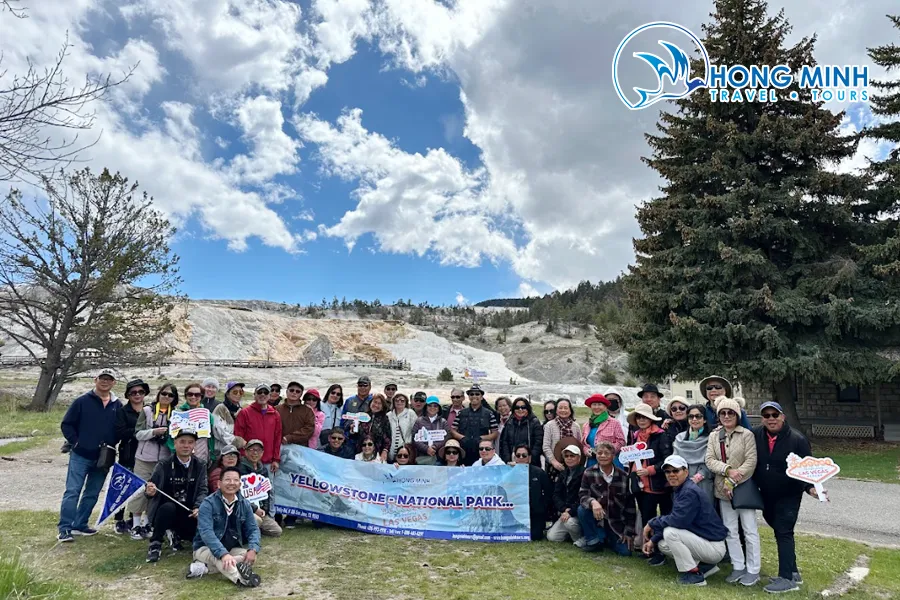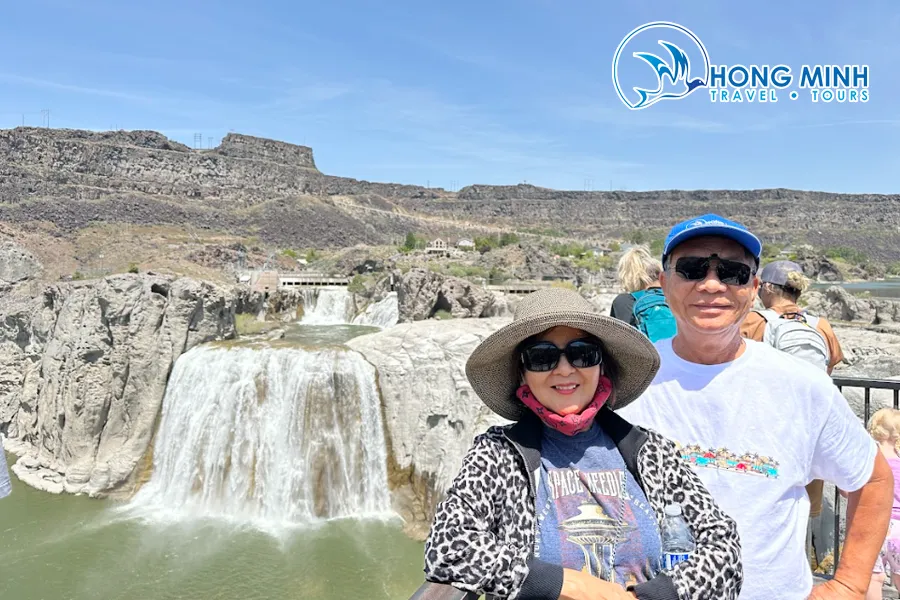Wyoming, the mountainous western state of the USA, is renowned for its untouched, majestic beauty and diverse landscapes. From snow-capped peaks year-round and vast grasslands to dramatic red rock canyons, Wyoming also harbors another priceless treasure – stunning waterfalls. If you are a landscape photography enthusiast and want to capture impressive moments of nature, Wyoming is the ideal destination to unleash your creativity with the waterfall theme. This article will share secrets and experiences for “hunting” the most beautiful waterfalls in Wyoming, helping you create timeless masterpieces.
Wyoming is not only home to the world-famous Yellowstone National Park but also the origin of countless waterfalls of all sizes, hidden in dense forests, deep canyons, or winding rivers. Each waterfall possesses a unique beauty, from the grandeur and ferocity of large falls like Lower Falls in the Grand Canyon of the Yellowstone, to the soft, graceful beauty of smaller waterfalls, weaving through the wilderness. To “hunt” the most beautiful Wyoming waterfall photos, you need thorough preparation in knowledge, skills, and equipment, as well as choosing the right time and location.
Explore Waterfall Hotspots in Wyoming
Wyoming boasts many areas with beautiful waterfalls, but the most prominent must be Yellowstone National Park and its surroundings. Yellowstone is not only famous for geysers and hot springs but also a waterfall paradise, with hundreds of waterfalls large and small. Below are some of the most famous and accessible waterfalls in Yellowstone National Park that you shouldn’t miss:
1. Lower Falls of the Grand Canyon of the Yellowstone
Lower Falls is one of the symbols of Yellowstone National Park and one of the most magnificent waterfalls in the United States. With a height of over 94 meters, this waterfall plunges from a height twice that of Niagara Falls, creating an awe-inspiring and impressive spectacle. To get the best panoramic photos of Lower Falls, you can go to Artist Point or Inspiration Point, both located on the South Rim of the Grand Canyon of the Yellowstone. From Artist Point, you can capture the entire waterfall cascading down the canyon with vibrant yellow cliffs, especially beautiful in the early morning or late afternoon when the sunlight shines at an angle.

2. Upper Falls of the Grand Canyon of the Yellowstone
Located just above Lower Falls, Upper Falls is smaller but still very beautiful and worth exploring. With a height of about 33 meters, Upper Falls creates a powerful flow, cascading into the yellow rock canyon. You can easily access Upper Falls from Uncle Tom’s Trail or Brink of the Upper Falls Trail. Uncle Tom’s Trail is a steep trail with many steps leading down near the base of the falls, giving you the opportunity to admire the waterfall up close and impressively. Brink of the Upper Falls Trail is a short, easy trail leading to a viewpoint right above the falls, where you can feel the power and ferocity of the water flow.
3. Firehole Falls
Located in the Firehole Canyon Drive area, Firehole Falls is a small but very graceful and lovely waterfall. This waterfall cascades from a height of about 12 meters, forming a small, clear blue lake, ideal for swimming in the summer. The special feature of Firehole Falls is the distinctive reddish-orange water color due to the influence of minerals in the geothermal area. You can easily photograph Firehole Falls from many different angles, from above looking down, or from below looking up, all offering beautiful and unique frames.
4. Gibbon Falls
Gibbon Falls is located along the Gibbon River, between Madison and Norris Geyser Basin. This is a tiered waterfall, cascading from a height of about 26 meters, with a white water flow standing out against the backdrop of lush green pine forests. The Gibbon Falls viewpoint is located right next to the road, very easy to access and photograph. You can photograph Gibbon Falls from a distance to see the entire waterfall and surrounding forest, or get closer to capture close-ups of the cascading water and mossy rocks.
5. Kepler Cascades
Located along the Firehole River, south of Old Faithful, Kepler Cascades is a series of small, consecutive waterfalls, cascading from a height of about 15 meters. Kepler Cascades is not as majestic as Lower Falls, but it has its own soft and graceful beauty. The Kepler Cascades viewpoint is located right on the road, with parking and an easily accessible walking path. You can photograph Kepler Cascades from many different angles, from panoramic to close-up, to capture the diverse beauty of this series of waterfalls.
Professional Tips for Wyoming Waterfall Photography
To capture beautiful and impressive Wyoming waterfall photos, you need to master some professional photography techniques and tips. Here are important factors to keep in mind:
1. Choose the Right Time to Shoot
The ideal time to photograph waterfalls is in the early morning or late afternoon when the sunlight is soft and angled. This light will create soft shadows, highlighting the texture and details of the waterfall and surrounding landscape. Avoid shooting in midday when harsh sunlight shines directly down, causing overexposure and loss of detail. In addition, the weather is also an important factor. Overcast days or after rain are great times to photograph waterfalls, as diffused light will reduce contrast and create soft, harmonious colors.
2. Use Appropriate Equipment
To take beautiful waterfall photos, you need to equip yourself with some basic equipment such as:
- Camera: DSLR or mirrorless cameras with the ability to adjust aperture, shutter speed, and ISO are the best choices.
- Lens: Wide-angle lenses (e.g., 16-35mm) will help you capture panoramic views of the waterfall and surrounding landscape. Telephoto lenses (e.g., 70-200mm) will help you capture close-ups of waterfall details or other interesting elements in the frame.
- Tripod: A tripod is an indispensable piece of equipment when photographing waterfalls, especially when you want to use slow shutter speeds to create a smooth water effect.
- ND Filter: ND (Neutral Density) filters help reduce the amount of light entering the lens, allowing you to use slow shutter speeds even in bright light conditions.
- Polarizing Filter: Polarizing filters help reduce glare and reflections on water surfaces and leaves, increasing the contrast and color saturation of the photo.
3. Apply Slow Shutter Speed Technique
The slow shutter speed technique is one of the most important techniques when photographing waterfalls. Using a slow shutter speed (e.g., from 1/2 second to several seconds or even minutes) will make the water flow become smooth and silky, creating a beautiful and impressive motion blur effect. To shoot at slow shutter speeds, you need to use a tripod to keep the camera stable and an ND filter to reduce the amount of light. Experiment with different shutter speeds to find the most suitable speed for each lighting condition and desired effect.
4. Pay Attention to Composition and Angle
Composition and shooting angle play an important role in creating a beautiful and compelling waterfall photo. Look for unique and creative shooting angles, instead of just shooting from common viewpoints. Experiment with shooting angles from above looking down, from below looking up, or from the side of the waterfall. Pay attention to arranging elements in the frame, such as waterfalls, trees, rocks, sky, to create a balanced, harmonious, and deep composition. Use leading lines such as rivers, trails, or rows of trees to guide the viewer’s eye to the waterfall.
5. Explore Creativity with Different Perspectives
Don’t be afraid to experiment and explore different shooting angles and techniques to create unique waterfall photos that bear your personal mark. You can try shooting panoramic photos to capture the majesty of the waterfall and the surrounding landscape, shooting close-up photos to focus on interesting details such as water flow, white water, rocks, moss, or shooting black and white photos to create highly expressive artistic works.

Safety First
When “hunting” waterfalls in Wyoming, always put safety first. The terrain around waterfalls is often slippery and dangerous, especially areas near the edge of the falls or on wet rocks. Wear appropriate footwear, be careful when moving, and follow safety signs and instructions. Do not risk getting too close to the edge of the falls or dangerous areas to take pictures. Always remember that no photo is worth your safety.
Conclusion
Wyoming is a true paradise for photographers passionate about waterfalls. With diverse terrain and landscapes, along with countless beautiful and majestic waterfalls, Wyoming offers you endless opportunities to create and capture wonderful moments of nature. Hopefully, the above sharing will help you gain more knowledge and experience to “hunt” the most beautiful Wyoming waterfall photos. Plan your Wyoming trip today and discover the magical beauty of the waterfalls here!